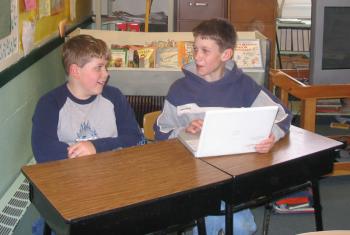Dillon R.

Finding Friendship Oral History Project
The Finding Friendship Oral History Project is a joint effort of the Friendship Museum and the Friendship Village School, directed by Sally Merrick, museum volunteer, and Gaylea Hynd, teacher. In 2003-2004 sixth grade students conducted taped interviews of three generations of lobstermen and women, as well as others associated with the lobstering industry. Printed copies of the interviews and CDs of the printed transcripts are available at the Friendship Museum in Friendship, Maine.
Douglas
Dillon
Born and raised in Friendship Village, Dillon comes from a long line of lobstering tradition, with his father, grandfather, and sister all actively involved in the industry. Dillon has been lobstering for several years, having obtained his junior license at the age of six. Now, at the age of twelve, he has gained enough experience and confidence to venture out on his own, navigating the waters of Walkers Beach in pursuit of the prized crustaceans. He fishes in an 18-foot boat and sets 100-150 traps.
Scope and Content Note
In this interview conducted by Douglas at Friendship Village School, Dillon provides valuable insights into the life of a young lobsterman. He shares details about his journey into lobstering, starting from when he first acquired his license at six years old, to the point where he began venturing out alone at the age of nine or ten. Dillon talks about his family's involvement in the industry, with his father and sister often accompanying him on his lobstering trips. Dillon's dedication to lobstering is evident as he discusses the frequency of his trips, typically going out two or three times a week during the summer months. Although he currently holds a junior license, Dillon eagerly anticipates upgrading to an official license next year, emphasizing the process involved in applying for a license. The young lobsterman shares insights into the practical aspects of his trade, including how he selects locations to set his traps and the daily routine he follows, starting as early as 5 a.m. Dillon highlights his versatility on the boat, undertaking various tasks such as hauling traps, baiting them, and measuring and banding the lobsters he catches. He also mentions using specific bait types like herring and pogies to attract the lobsters. Dillon provides a glimpse into the challenges and rewards of lobstering, discussing topics like avoiding lobster pinches, identifying the appropriate size of lobsters to catch, and encountering other fish species in his traps. He also mentions the diverse sea life he encounters, such as porpoises, seals, and seagulls. Additionally, Dillon talks about selling his catch at Hatchet Cove Co-op, his boat, named Crustaceans Nightmare, and the practicalities of lobstering, including using a bucket as a bathroom on the boat and wearing specialized gear like oil pants, knee boots, a hat, and gloves for hauling. The interview concludes with Dillon's reflections on the financial aspect of lobstering and his personal lobster consumption, demonstrating his passion and dedication to his trade.
Please Note: The oral histories in this collection are protected by copyright and have been created for educational, research and personal use as described by the Fair Use Doctrine in the U.S. Copyright law. Please reach out Voices@noaa.gov to let us know how these interviews are being used in your research, project, exhibit, etc. The Voices staff can help provide other useful resources related to your inquiry.
The NOAA mission is to understand and predict changes in climate, weather, oceans, and coasts, to share that knowledge and information with others, and to conserve and manage coastal and marine ecosystems and resources. The Voices Oral History Archives offers public access to a wide range of accounts, including historical materials that are products of their particular times, and may contain offensive language or negative stereotypes.
Voices Oral History Archives does not verify the accuracy of materials submitted to us. The opinions expressed in the interviews are those of the interviewee only. The interviews here have been made available to the public only after the interviewer has confirmed that they have obtained consent.
